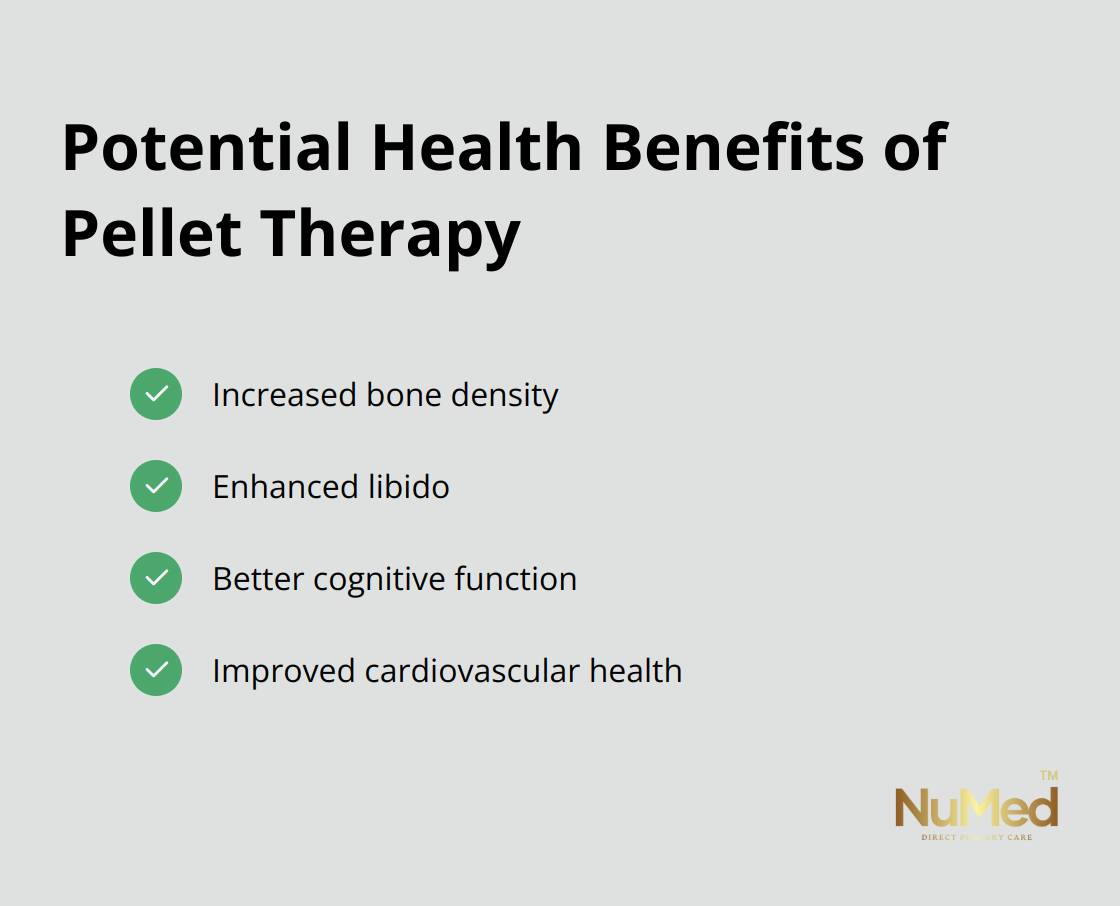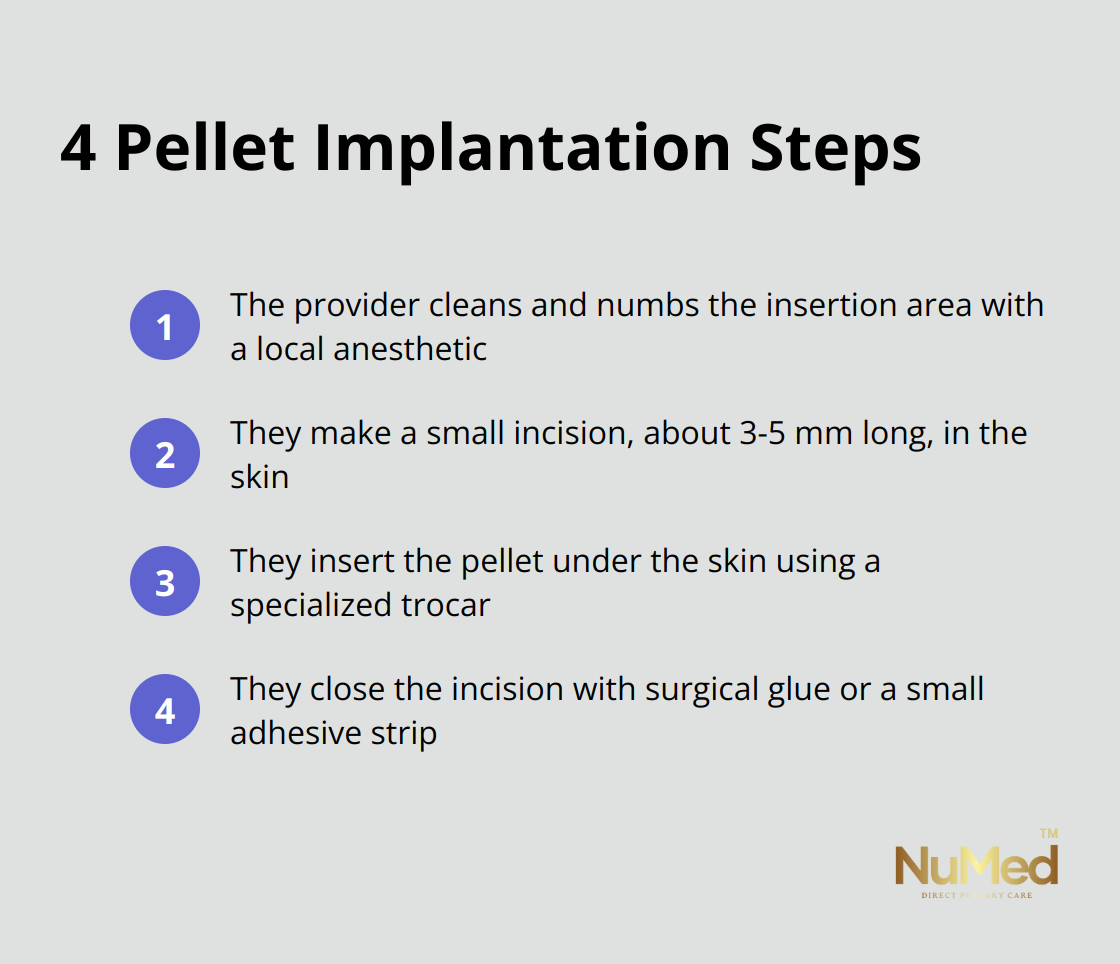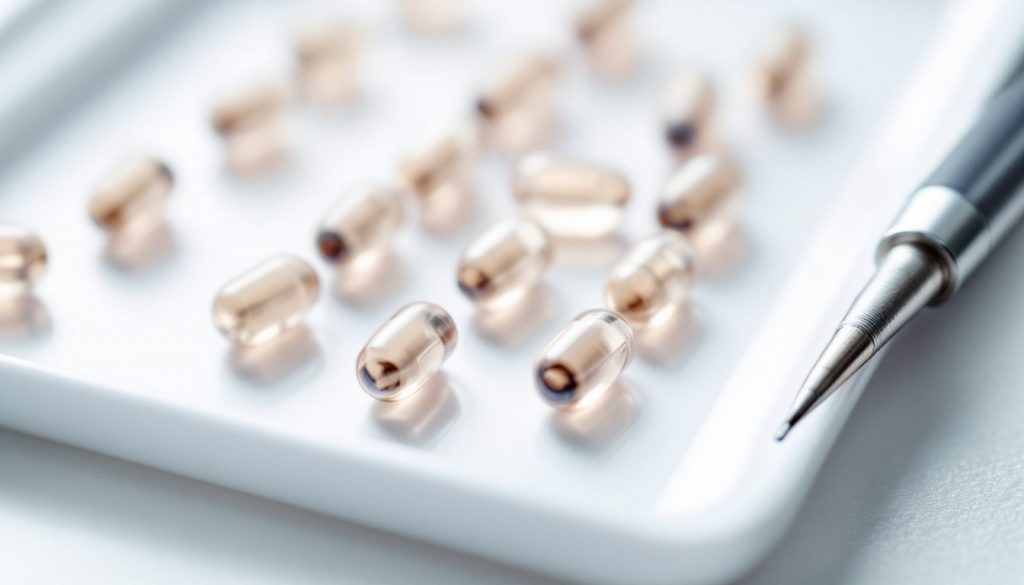At NuMed DPC, we’re excited to introduce you to a game-changing option in hormone therapy: pellet implants.
This innovative method offers a consistent and convenient way to balance hormones, potentially improving various aspects of health.
In this post, we’ll explore how pellets for hormone therapy work, their benefits, and what to expect during the procedure.
What Are Hormone Pellets?
Composition and Function
Hormone pellets are small, cylindrical implants about the size of a grain of rice. These pellets serve as a form of bioidentical hormone replacement therapy (BHRT). Natural plant sources provide the raw materials for these tiny solid cylinders. The pellets contain hormones like estradiol or testosterone, which match the molecular structure of hormones your body produces naturally. Doctors insert these pellets under the skin, typically in the hip area, where they release hormones into your bloodstream over several months.
How Pellets Work in Your Body
After implantation, the pellets dissolve gradually, providing a steady stream of hormones. This method mimics your body’s natural hormone production and avoids the fluctuations often associated with other forms of hormone therapy. The consistent release can last anywhere from 3 to 6 months (depending on the individual and the specific pellet used).
Pellets vs. Other Hormone Therapy Methods
Pellet therapy offers several advantages compared to daily pills, creams, or patches:
- Improved Compliance: It eliminates the need for daily medication.
- Stable Hormone Levels: Unlike pills or creams that can cause hormone fluctuations throughout the day, pellets maintain a consistent level. This stability often results in fewer side effects and more predictable symptom relief.
- Reduced User Error: There’s no chance of forgetting to take a pill or apply a cream, ensuring you receive the correct dose consistently.

Customization and Effectiveness
Healthcare providers can tailor pellet therapy to individual needs. They adjust the hormone dosage based on comprehensive blood tests and symptom evaluation. This personalized approach (which takes into account factors like age, weight, and medical history) enhances the effectiveness of the treatment.
Safety Considerations
While pellet therapy offers numerous benefits, it’s important to discuss potential risks with a qualified healthcare provider. They can help determine if this method is suitable for your specific health situation. Some individuals may experience minor side effects (such as temporary bruising at the insertion site), but serious complications are rare when performed by experienced professionals.
As we explore the benefits of pellet implant therapy in the next section, you’ll gain a deeper understanding of how this innovative treatment can potentially improve various aspects of your health and well-being.
Why Pellet Implants Stand Out
Consistent Hormone Delivery
Pellet implants offer a revolutionary approach to hormone therapy. Unlike daily pills or creams, these implants release hormones steadily into the bloodstream. This consistency often results in more stable moods and energy levels throughout the day.
Reduced Side Effects
Pellet implants typically cause fewer side effects than other hormone therapy methods. The steady hormone release prevents sudden spikes or drops, which often trigger unwanted reactions.
Unmatched Convenience
Pellet implants eliminate the need for daily medication routines. A single implant can last 3 to 6 months, depending on individual needs. This convenience often leads to improved treatment adherence.
Hormone replacement therapy (HRT) replenishes women with ovarian hormones diminished during the natural menopausal transition to alleviate associated symptoms.
Comprehensive Health Benefits
Pellet therapy doesn’t just address hormone-related symptoms; it can potentially improve various aspects of overall health. Patients often report:
- Increased bone density
- Enhanced libido
- Better cognitive function
- Improved cardiovascular health

These benefits highlight the potential of pellet implants to transform hormone therapy. However, individual results may vary, and it’s essential to consult with a qualified healthcare provider to determine if this method suits your specific needs. Let’s explore the pellet implant procedure to understand what patients can expect during treatment.
What Happens During a Pellet Implant Procedure?
Pre-Treatment Assessment
The pellet implant process starts with a comprehensive evaluation. Healthcare providers conduct a thorough medical history review, physical examination, and blood tests. These tests measure hormone levels, thyroid function, and other relevant markers. The Journal of Clinical Endocrinology & Metabolism emphasizes the importance of this assessment for determining appropriate hormone dosage and identifying potential contraindications.
The Implantation Process
The pellet implantation procedure is quick and minimally invasive. Here’s what patients can expect:

Patients often report minimal discomfort during the procedure.
Post-Procedure Care
After the implantation, patients receive detailed instructions for post-procedure care. These typically include:
- Keeping the insertion site dry for 24-48 hours
- Avoiding strenuous physical activity for a few days
- Watching for signs of infection
Follow-Up Appointments
Healthcare providers schedule follow-up appointments to assess hormone levels and address any concerns. In general, men may need pellet insertion every 5 to 6 months, while women may require it every 3 to 4 months.
Patient Comfort and Education
Healthcare teams prioritize patient comfort and education throughout the entire process. Nurses play an important role in counseling and supporting individuals through the menopause transition with evidence-based guidance. Patients who understand the procedure and actively participate in their care (through asking questions and following post-procedure instructions) tend to have the best outcomes.
Final Thoughts
Pellets for hormone therapy offer significant advancements in hormone replacement. This innovative approach provides consistent hormone delivery, fewer side effects, and unparalleled convenience. However, hormone therapy is not a universal solution, and individual needs vary greatly.
Consultation with a qualified healthcare provider remains essential before starting any hormone therapy regimen. A thorough evaluation (including comprehensive blood tests and a detailed medical history review) helps determine if pellet implants suit your specific needs. Ongoing research in hormone therapy promises further refinements and improvements in pellet implant technology.
At NuMed Direct Primary Care, we provide personalized, holistic healthcare that addresses root causes of health issues. Our approach to hormone therapy, including pellet implants, forms just one aspect of our comprehensive services. We invite you to explore how our direct primary care model can benefit your overall wellness.
















